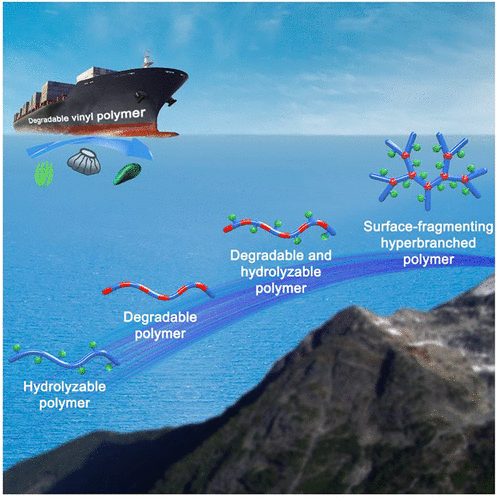当前位置:
X-MOL 学术
›
Acc. Chem. Res.
›
论文详情
Our official English website, www.x-mol.net, welcomes your feedback! (Note: you will need to create a separate account there.)
Degradable Vinyl Polymers for Combating Marine Biofouling
Accounts of Chemical Research ( IF 18.3 ) Pub Date : 2022-05-11 , DOI: 10.1021/acs.accounts.2c00187 Jiansen Pan 1 , Xiaoqing Ai 1 , Chunfeng Ma 1 , Guangzhao Zhang 1
Accounts of Chemical Research ( IF 18.3 ) Pub Date : 2022-05-11 , DOI: 10.1021/acs.accounts.2c00187 Jiansen Pan 1 , Xiaoqing Ai 1 , Chunfeng Ma 1 , Guangzhao Zhang 1
Affiliation

|
Marine organisms such as barnacle larvae and spores of algae adhere to underwater surfaces leading to marine biofouling. This phenomenon has numerous adverse impacts on marine industries and maritime activities. Due to the diversity of fouling organisms and the complexity of the marine environment, it is a huge challenge to combat marine biofouling, which limits the development and utilization of marine resources. Since the International Marine Organization banned the use of tributyltin self-polishing copolymer (SPC) coatings in 2008, the development of an environmentally friendly and efficient anti-biofouling polymer has been the most important task in this field. Tin-free SPC is a well-established and widely used polymer binder for anti-biofouling coating today. Being a nondegradable vinyl polymer, SPC exhibits poor anti-biofouling performance in static conditions. Even more, such nondegradable polymers were considered to be a source of microplastics by the International Union for the Conservation of Nature in 2019. Recently, numerous degradable polymers, which can form dynamic surface through main chain scission, have been developed for preventing marine biofouling in static conditions. Nevertheless, the regulation of their degradation and mechanical properties is limited, and they are also difficult to functionalize. A new polymer combining the advantages of vinyl polymers and degradable polymers is needed. However, such a combination is a challenge since the former are synthesized via free radical polymerization whereas the latter are synthesized via ring-opening polymerization.
中文翻译:

用于对抗海洋生物污损的可降解乙烯基聚合物
藤壶幼虫和藻类孢子等海洋生物附着在水下表面,导致海洋生物污损。这种现象对海洋工业和海上活动产生了许多不利影响。由于污损生物的多样性和海洋环境的复杂性,防治海洋生物污损是一项巨大的挑战,限制了海洋资源的开发利用。自2008年国际海事组织禁止使用三丁基锡自抛光共聚物(SPC)涂料以来,开发环保高效的抗生物污损聚合物一直是该领域的重中之重。无锡 SPC 是一种成熟且广泛使用的聚合物粘合剂,可用于当今的防生物污损涂层。作为不可降解的乙烯基聚合物,SPC 在静态条件下表现出较差的抗生物污染性能。更重要的是,这种不可降解的聚合物在 2019 年被国际自然保护联盟认为是微塑料的来源。最近,已经开发出许多可通过主链断裂形成动态表面的可降解聚合物,用于防止海洋生物污染。静态条件。然而,它们的降解和机械性能的调节是有限的,并且它们也难以功能化。需要一种结合乙烯基聚合物和可降解聚合物优点的新型聚合物。然而,这种组合是一个挑战,因为前者是通过自由基聚合合成的,而后者是通过开环聚合合成的。这种不可降解的聚合物在 2019 年被国际自然保护联盟认为是微塑料的来源。最近,已经开发出许多可通过主链断裂形成动态表面的可降解聚合物,用于防止静态条件下的海洋生物污染。然而,它们的降解和机械性能的调节是有限的,并且它们也难以功能化。需要一种结合乙烯基聚合物和可降解聚合物优点的新型聚合物。然而,这种组合是一个挑战,因为前者是通过自由基聚合合成的,而后者是通过开环聚合合成的。这种不可降解的聚合物在 2019 年被国际自然保护联盟认为是微塑料的来源。最近,已经开发出许多可通过主链断裂形成动态表面的可降解聚合物,用于防止静态条件下的海洋生物污染。然而,它们的降解和机械性能的调节是有限的,并且它们也难以功能化。需要一种结合乙烯基聚合物和可降解聚合物优点的新型聚合物。然而,这种组合是一个挑战,因为前者是通过自由基聚合合成的,而后者是通过开环聚合合成的。许多可降解聚合物可以通过主链断裂形成动态表面,已被开发用于防止静态条件下的海洋生物污染。然而,它们的降解和机械性能的调节是有限的,并且它们也难以功能化。需要一种结合乙烯基聚合物和可降解聚合物优点的新型聚合物。然而,这种组合是一个挑战,因为前者是通过自由基聚合合成的,而后者是通过开环聚合合成的。许多可降解聚合物可以通过主链断裂形成动态表面,已被开发用于防止静态条件下的海洋生物污染。然而,它们的降解和机械性能的调节是有限的,并且它们也难以功能化。需要一种结合乙烯基聚合物和可降解聚合物优点的新型聚合物。然而,这种组合是一个挑战,因为前者是通过自由基聚合合成的,而后者是通过开环聚合合成的。需要一种结合乙烯基聚合物和可降解聚合物优点的新型聚合物。然而,这种组合是一个挑战,因为前者是通过自由基聚合合成的,而后者是通过开环聚合合成的。需要一种结合乙烯基聚合物和可降解聚合物优点的新型聚合物。然而,这种组合是一个挑战,因为前者是通过自由基聚合合成的,而后者是通过开环聚合合成的。
更新日期:2022-05-11
中文翻译:

用于对抗海洋生物污损的可降解乙烯基聚合物
藤壶幼虫和藻类孢子等海洋生物附着在水下表面,导致海洋生物污损。这种现象对海洋工业和海上活动产生了许多不利影响。由于污损生物的多样性和海洋环境的复杂性,防治海洋生物污损是一项巨大的挑战,限制了海洋资源的开发利用。自2008年国际海事组织禁止使用三丁基锡自抛光共聚物(SPC)涂料以来,开发环保高效的抗生物污损聚合物一直是该领域的重中之重。无锡 SPC 是一种成熟且广泛使用的聚合物粘合剂,可用于当今的防生物污损涂层。作为不可降解的乙烯基聚合物,SPC 在静态条件下表现出较差的抗生物污染性能。更重要的是,这种不可降解的聚合物在 2019 年被国际自然保护联盟认为是微塑料的来源。最近,已经开发出许多可通过主链断裂形成动态表面的可降解聚合物,用于防止海洋生物污染。静态条件。然而,它们的降解和机械性能的调节是有限的,并且它们也难以功能化。需要一种结合乙烯基聚合物和可降解聚合物优点的新型聚合物。然而,这种组合是一个挑战,因为前者是通过自由基聚合合成的,而后者是通过开环聚合合成的。这种不可降解的聚合物在 2019 年被国际自然保护联盟认为是微塑料的来源。最近,已经开发出许多可通过主链断裂形成动态表面的可降解聚合物,用于防止静态条件下的海洋生物污染。然而,它们的降解和机械性能的调节是有限的,并且它们也难以功能化。需要一种结合乙烯基聚合物和可降解聚合物优点的新型聚合物。然而,这种组合是一个挑战,因为前者是通过自由基聚合合成的,而后者是通过开环聚合合成的。这种不可降解的聚合物在 2019 年被国际自然保护联盟认为是微塑料的来源。最近,已经开发出许多可通过主链断裂形成动态表面的可降解聚合物,用于防止静态条件下的海洋生物污染。然而,它们的降解和机械性能的调节是有限的,并且它们也难以功能化。需要一种结合乙烯基聚合物和可降解聚合物优点的新型聚合物。然而,这种组合是一个挑战,因为前者是通过自由基聚合合成的,而后者是通过开环聚合合成的。许多可降解聚合物可以通过主链断裂形成动态表面,已被开发用于防止静态条件下的海洋生物污染。然而,它们的降解和机械性能的调节是有限的,并且它们也难以功能化。需要一种结合乙烯基聚合物和可降解聚合物优点的新型聚合物。然而,这种组合是一个挑战,因为前者是通过自由基聚合合成的,而后者是通过开环聚合合成的。许多可降解聚合物可以通过主链断裂形成动态表面,已被开发用于防止静态条件下的海洋生物污染。然而,它们的降解和机械性能的调节是有限的,并且它们也难以功能化。需要一种结合乙烯基聚合物和可降解聚合物优点的新型聚合物。然而,这种组合是一个挑战,因为前者是通过自由基聚合合成的,而后者是通过开环聚合合成的。需要一种结合乙烯基聚合物和可降解聚合物优点的新型聚合物。然而,这种组合是一个挑战,因为前者是通过自由基聚合合成的,而后者是通过开环聚合合成的。需要一种结合乙烯基聚合物和可降解聚合物优点的新型聚合物。然而,这种组合是一个挑战,因为前者是通过自由基聚合合成的,而后者是通过开环聚合合成的。



























 京公网安备 11010802027423号
京公网安备 11010802027423号